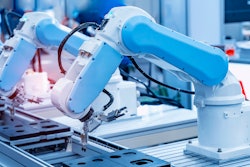With its roller doors and a squat build, GE’s composites manufacturing lab in Munich looks from the outside like many other garages in this Bavarian city where mechanics might work on Audis and BMWs. But walk through those doors and you’ll be greeted by a large robotic arm weaving composite parts from a long strand of a light and strong carbon fibers.
Carbon fiber composites have been around for decades, of course. The material, which can be as strong as steel or aluminum but much lighter, is being used for car chassis, aircraft fuselage, and other parts where the mix of strength and light weight is valued at a premium.
But making composites has traditionally been a manual process. A typical composite part looks like high-tech baklava made from alternating layers of carbon fiber sheets and resin. Workers lay down each layer by hand and bake the final shape in an industrial-size pressure cooker called autoclave.
However, the latest generation of composite components like jet engine fan blades (see below) have complex 3D shapes, which are very difficult to make. That’s where robots could come handy. The Munich team, which is part of the GE Global Research center there, is giving these robots more powerful brains and senses so they can get better at the job.
The carbon fiber running through the robotic arm (see top image) is smooth like linen, but also up to five times stronger than steel and more than four times lighter. “You’d like to put it everywhere,” says Dragan Filipovic, a GE composites manufacturing research engineer working at the Munich lab. ”But it’s very expensive.”
Filipovic is on a team trying to optimize robotic composite manufacturing and lower the cost of components made from the material. He is making his robots listen to special design software, lay down the material efficiently, and eventually create complex shapes that humans have struggled to achieve.
Composites manufacturers have already started to deploy industrial robots in factories. They are helping workers make complex 3D structures from layers of woven carbon fiber. The composite fan blades for the LEAP jet engine, for example, are made by a proprietary process that weaves fiber in three dimensions on a loom into their final shape. Workers then they inject these carbon fiber “preforms” with resin and bake them in an autoclave. (The final step is adding a titanium leading edge to increase durability.)
Filipovic and his colleague Stefaan Van Nieuwenhove are now endowing their robots mathematical modeling skills, real-time 3D laser scanning abilities, computer vision analytics and other sensing talents. They want to make them aware of the work they are doing while it is happening.
“Eventually our instruments will be fully integrated into the brains of these machines,” says Van Nieuwenhove. He says that the process will allow the machine to know “how it needs to react to changes in the manufacturing process it is working on.”
"That’s a smart machine," he says. "We call it adaptable manufacturing.”
For more stories like this, check out GE Reports.






















